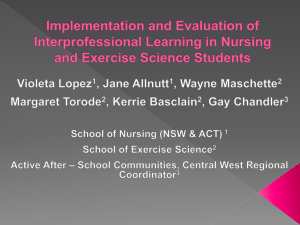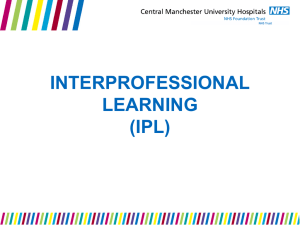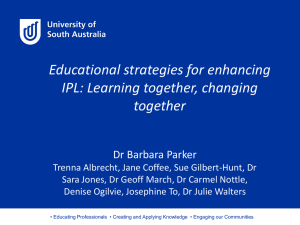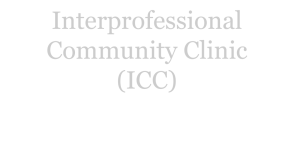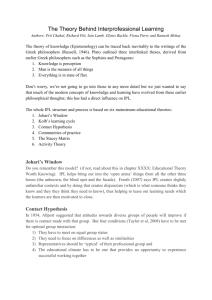the Powerpoint presentation from the keynote speaker
advertisement
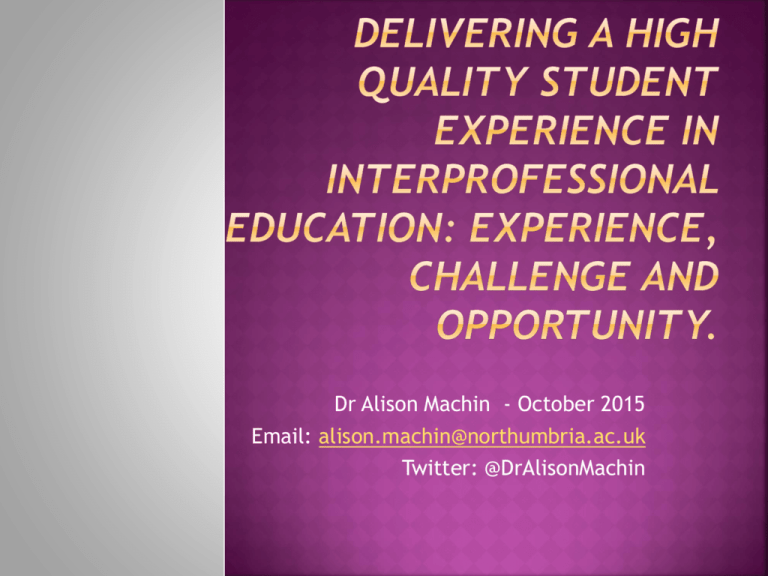
Dr Alison Machin - October 2015 Email: alison.machin@northumbria.ac.uk Twitter: @DrAlisonMachin • • • • • To provide an overview of IPE at Northumbria University To present a research study undertaken to explore students’ assessment content as outcomes of their IPE experience To present a second research study which focused on facilitators of IPE and our identified implications for developing and supporting them To reflect on our key challenges in maintaining a high quality student experience To conclude with key opportunities for maximising students’ IPE experience 16 year history of delivering IPE within mainstream programmes Initial model was one module in each year nursing (all fields), midwifery, physiotherapy, occupational therapy, Operating Department Practice and Social Work. Lots of lessons learned including the need for clear leadership 2003 Director of IPE appointed, full time, Principal Lecturer 1st key development in 2006 brought together the suite of pre-registration health programmes in a single curriculum framework • • • • • Core philosophy: Recognising similarity, valuing difference A focus on Core, Common, Collaborative competency development (Barr et al 2005) Two cross programme modules in each year – some programmes with 2 intakes, around 1200 students/ year Learning and teaching strategy combined uniprofessional, multi-professional and interprofessional approaches within the same module. This helped students to develop their own professional identity whilst at the same time to understand where professional skills sets are common across professions and to learn how to work together. Foundations of Learning and Collaborative Working Core skills for professional practice Developing skills of collaborative working Development of core skills of professional practice Core skills for professional practice – transition Collaborative Working for Service Improvement To provide a critical appraisal of: a) the rationale for inter-professional, patient/ client/ service user focused health and social care delivery. b) the underpinning evidence base for providing an inter-professional service in a specific practice area and/or patient/ client/ service user group in relation to safety and service improvement. c) the factors influencing the ongoing improvement and delivery of an interprofessional service in a specific practice area and/or patient/ client/ service user group. “an incident or lived experience arising during contact with health, social care and education services which causes distress or harm (physical, emotional, psychological) to service users and their families”. (Machin and Jones 2014) undertake a service improvement project related to their practice experience present their project, in the form of an electronic poster, to their IPL group, academic marker, and service user and/or practitioner, who gave formative feedback to the students through Q&A/discussion submit an A4, hard copy of their poster with a bullet point reflective annotation based on feedback received during assessment and their experience in the IPL service improvement process Warren (2007) holistic model of involvement consultation Information S.U. Weekly House Meetings Participation Achieve task Information sharing and involvement forum for service users and staff Legislation and policy GSCC Code of Conduct Build team Develop individuals empowerment HOW •Plsek (2000) Complex Adaptive Systems Wright et al (2006) whole systems approach •Capra (2002) Structures, Processes, Patterns • empowerment • Kirby et al (2003) benefits to S.U. And organisation •The Children Now Participation Charter (2006) Results •Regular meetings •Service user involvement in process development •Minutes used to feed into staff meetings • consultation act study • information SERVICE USER INVOLVEMENT Overall organisational culture and policies plan Evaluation Honey and Mumford (2004) prospective approach to learning Leish (1997) action centred leadership do • participation Service user culture Staff culture Sphere of professional influence Carmel Peters – Social Work Student Midwifery project to raise awareness of the IP team in a maternity department about the maternity information in other languages freely available on the web. Added to a local care-plan checklist of things to consider in an initial assessment Nursing student - Local implementation of national guidance on timely dispensing of medication – stickers on notes, information for patients, posters etc all already available, but the local implementation improved the service user experience in that local setting Physiotherapy student’s implementation of a “traffic light” system on white board by the patient’s bedside indicating to the wider team the patient’s mobility level What are the service user experiences that trigger students' choice of service improvement project; What were the project ideas students devised to address identified areas for improvement in their practice learning context; How do students' perceive their key learning from the experience and its relevance for their qualified practice? Interpretive paradigm/ qualitative design (Blaikie 2007) Content Analysis (Krippindorf 2004) Framework for analysis: Unit of analysis/meaning unit/condensation/ abstraction analysis (Granneheim and Lundman 2004) Descriptive Statistics 150 students (total cohort = 420) Learning disability nursing (LDN) (n = 2) Midwifery (MW) (n = 12); Mental health nursing (MHN) (n = 9); Children's nursing (CN) (n = 12); Adult nursing (AN) (n = 50); Social work (SW) (n = 25); Physiotherapy (PT) (n = 20); Occupational therapy (OT) (n = 20). Assessment posters and reflections were analysed in relation to each of the research questions Once all service improvement triggers and ideas were analysed by professional group they were categorised by frequency of category recurrence (with percentages) was collated within and across the professionals groups. This facilitated some cross group, cross theme analysis drawing on the elements of qualitative comparative analysis (Berg-Schlosser, 2009) There were no distinguishable differences between professional groups reflected in their learning experiences, possibly due to the interprofessional small group nature of the student shared learning journey, therefore no attempt was made to quantify the recurrence of key learning points. Service users disempowered by care environment and/or routine Unmet need due to gap in service/resources Lack of information causing service user/carer anxiety Poorly facilitated transition between services/settings Poor/inconsistent interprofessional/interagency communication resulting in misunderstanding and anxiety Lack of understanding of professional roles Duplication of professional roles causing confusion Improve interprofessional communication and teamwork Improvements in written information available Interprofessional education initiatives Adapting the therapeutic environment/routine to improve outcomes Creating “products” to complement service provision Support groups & anxiety management initiatives Implementing existing care protocols Systems to improve access to services New quality monitoring/audit systems Students' service improvement IPL can largely be divided into two domains — knowledge development and personal and professional development in relation to: themselves (intrapersonal learning) their relationships with others (interprofessional learning). Intrapersonal knowledge gained clearly reflected the taught component of the module: “Neglect of a simple task can have a wide negative impact on patients‘ and relatives' psychological safety”. [AN21] Interprofessional knowledge gained included better role awareness: “I feel I learned a lot from my buddy group … about different professional roles in the health service, the work they're responsible for, difficulties they face, policy drivers and systems they work in, research used and tools they use for assessment, planning and storage of data” [SW 20] It was clear that the experience had influenced students' personal growth and professional development: “Service improvement involving interprofessional groups and clients is a complex and crucial subject that I will continue to study and implement throughout my career” [CN9] This included a perceived increase in their selfconfidence as change agents in an interprofessional context: “I feel better equipped to go into practice and challenge the poor practice of other professionals” [CN7] Some students suggested they had developed an ability to give and receive interprofessional feedback, acknowledging the importance of mutual trust: “Working with my interprofessional buddy group enabled me to evaluate my own opinions and nursing practice by receiving constructive feedback to learn from positive and negative experiences” [AN41] Engaging positively in interprofessional service improvement learning as a student is an important rehearsal for life as a qualified practitioner. It can help students to develop an ability to challenge unsafe practice elegantly, thereby acting as advocates for the people in their care. Universities can play a key support role by working collaboratively with service organisations; role modelling effective interprofessional working; Evaluation of the module showed 97% of 227 respondents would recommend IP service improvement learning The research, our experiences and other student evaluations have helped us to continuously improve the IPL experiences within the curriculum, making more use of authentic, practice focused, student led small group IPL One key challenge that continued to be identified through student module evaluations and NSS qualitative feedback was that the facilitator had a key influence on the student experience We wanted to explore this in more depth as the issue persisted despite us running staff development sessions Research question: How do university educators in an IPL delivery team perceive the knowledge and skills needed for their role adequacy as IPL facilitators? Research Process RESEARCH METHODOLOGY/DESIGN •IPL facilitation is an interactive process in which learning takes places for all involved •This fits with symbolic interactionist theory (Mead 1934). •Grounded theory methodology (Glaser and Strauss 1967) •Constant comparative analysis used (sampling, data collection and data analysis occur concurrently until data saturation is reached). •Ethical approval granted •Informed by researchers’ theoretical sensitivity (Glaser 1978) SAMPLING •An email questionaire was sent to all IPL educators involved in the modules (n=30) and included questions such as experience as an educator, professional background, involvement in IPL modules. •25 responses to questionnaire received and answers were transposed onto a sampling matrix. •9 participants were selected based on the matrix , enabling theoretical sampling DATA ANALYSIS •Interviews were transcribed verbatim, •Line by line open coding was used becoming increasingly axial and theoretical as the study progressed (Strauss and Corbin 1990) •Data Categories were generated by grouping emerging themes and a core linking category identified. DATA COLLECTION •Digitally recorded, individual, Semistructured interviews •Broad interview guide used which evolved over time to allow for follow up of emerging categories and theoretical propositions “It is important that you go into the session with a positive perspective.. I often use a light hearted approach pick up the vibe from the students, (p 6). “Facilitator needs to be aware of what is going on in the classroom, they need to be inclusive and involve everyone so no one sits on the side line..." (p 3). "I think leadership style is important, you change your style depending on the situation, it is linked to emotional intelligence and being aware of self.." (p5). "You do need extra knowledge about how groups work to be able to get them going in class for the benefit of all students... it's like a social event.. it's about social skills development" (p 8) "I check the register before the session... I make sure I have examples from each group to include them in discussions.. if you not aware of this it can make them feel isolated and you les credible.." (p1) “I think it is important to know the group you are going into, acknowledge which professionals will be in the session so that you develop a good rapport with the students from the outset..” (p 4) "If you get a group that underperforms it is often due to a lack of team work, leadership and communication [by the facilitator]... not about the (professional) knowledge they have…" (p 5). “Most of my experience of IPL has been in the clinical environment where I facilitated education and training with mixed professional groups.. so I am able to use examples .. the idea of facilitating IPL does not phase me” (p2). “Sometimes I use personal examples of my own from my 20 years in health care to try to incorporate different perspectives…” (p1). “It’s good to bring in personal experiences when you have not got the professional background but I have is a lot of experience in teaching methods and facilitation of groups… I did feel out of my depth at the start but feel much more comfortable with IPL now” (p3). “ it’s about openness, honesty and being prepared to listen, valuing everyone and acknowledging them as individuals…” (p1). "It’s about appreciating people as individuals rather than just their profession.." (p5). "there is often a heavier contingent towards one group so you need to be mindful of including everyone in the discussion...it is so important that students leave the room with the right idea and not embed negative stereotypes...." (p6). Many of the skills identified were in keeping with the IPL literature and in our workshops however emphasis on their importance differed between participants Data showed that participants’ experience as an educator and/or a professional did not necessarily equate to confidence and skills in an IPL context. However this perception varied amongst individual participants Of significance in our analysis was the strength of comparability of participants’ perceptions of the skills needed for IPL facilitation and the skills widely acknowledged as needed for effective transformational leadership. The grounded theory generated, although propositional, suggests that the social process underpinning IPL facilitation in the setting studied “Transformational Interprofessional Learning Leadership”. 1. 2. 3. 4. “Individualized Consideration – the degree to which the leader attends to each follower's needs, empathises, supports, encourages, values Creating and Sustaining Group Culture through Transformational IPL Leadership Readiness for IPL facilitation Drawing on past IPL/IPW experiences Role modelling an interprofessional approach Intellectual Stimulation – the degree to which the leader challenges assumptions, takes risks and solicits followers' ideas. For such a leader, learning is a value and unexpected situations are seen as opportunities to learn. Inspirational Motivation – the degree to which the leader articulates a vision that is appealing and inspiring to followers. Communication skills that make the vision understandable, precise, powerful and engaging. Idealized Influence – Provides a role model for high ethical behaviour, instils pride, gains respect and trust”. To account for variation in perception we are planning an individualised staff development approach using for example: We IPL leadership coaching Peer shadowing to facilitate IPL role modelling IPL focused action learning style opportunities for reflective learning (individual & team) are planning further research: To test our propositional grounded theory which links IPL skills to leadership skills, in a wider range of settings and with different professional groups To study the impact of staff development activities on individuals’ IPL practice and the quality of the student IPL experience. Complexities of systems to support L&T in university and in practice learning settings Constantly changing staff base Managing student expectations Convincing others of its value Sustaining developments and enthusiasm Increasingly integrated health and social care systems across the UK Increasingly robust international research evidence base for the efficacy of IPL Widespread international community of IPL practice Thank you for listening! Any Questions? Barr, H., Koppel, I., Reeves, S., Hammick, M., & Freeth, D. (2005). Effective interprofessional education: Argument, assumption and evidence. Oxford: Blackwell Publishing. Bass & Bass 2008, The Bass Handbook of Leadership: Theory, Research, and Managerial Applications" 4th edition Free Press Berg-Schlosser, D., 2009. Qualitative Comparative Analysis (QCA) as an approach. In: Rihoux, B., Ragin, C. (Eds.), Configurational Comparative Methods. Qualitative Comparative Analysis (QCA) and Related Techniques. Sage, Thousand Oaks, pp.1–18. Blaikie, N., 2007. Approaches to Social Enquiry, 2nd ed. Polity Press, Cambridge Blumer, H., 1969. Symbolic Interactionism: Perspective and Method. Prentice-Hall, New Jersey. Derbyshire, J, Machin, A.I and Crozier, S (2015) Facilitating classroom based interprofessional learning: A grounded theory study of university educators’ perceptions of their role adequacy as facilitators. Nurse Education Today. 35 (1) 50-56 DOI: 10.1016/j.nedt.2014.05.001 Glaser, B., Strauss, A., 1967. The Discovery of Grounded Theory: Strategies for Qualitative Research. Aldine De Gruyter, New York. Graneheim, U.H., Lundman, B., 2004. Qualitative content analysis in nursing research: concepts, procedures and measures to achieve trustworthiness. Nurse Education Today 24, 105–112. Krippendorff, K., 2004. Content Analysis. An Introduction to Its Methodology, 2nd ed. Sage Publications, Thousand Oaks, California. Machin, A.I and Jones, D (2014)b Interprofessional Service Improvement Learning and Patient safety: A content analysis of pre-registration students’ assessments. Nurse Education Today, 34, 218-224 Mead, G., 1934. Mind, Self and Society. University of Chicago Press, Chicago. Strauss, A., Corbin, J., 1998. Basics of Qualitative Research: Grounded Theory Procedures and techniques. 2nd Ed. Sage Publications, Newbury Park, California.
